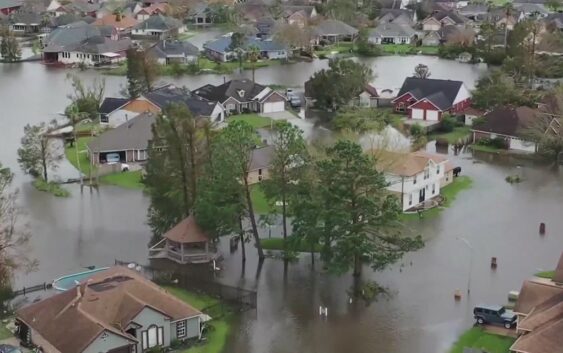- Fake job seekers are flooding the market, thanks to AI
- One set of evacuation orders lifted in Caldwell County after wildfire contained
- 'We gutted every building' | Chimney Rock rebuilding after Hurricane Helene
- 'We gutted every building' | Chimney Rock rebuilding after Hurricane Helene
- Debris from Hurricane Helene provides fuel, complicates containment for spring wildfires
What we learned from the 2024 National Hurricane Conference

The National Hurricane Center is gearing up and preparing for what could be a very busy season.
ORLANDO, Fla. — KHOU 11 Chief Meteorologist David Paul was the only Houston-area meteorologist who attended the National Hurricane Conference in Orlando this year.
The conference focused on all of the tools and technology that are being upgraded to better prepare meteorologists and residents for incoming storms.
Day 1
Paul said the first day of the conference focused on evacuations, which is a subject of great importance to anyone who remembers the stress surrounding Hurricane Rita and the mess that was the 2005 Houston/Galveston evacuation.
Since Rita, a lot of work and study has gone into understanding what emergency managers and residents need to safely move out of harm’s way. The key element that came up over and over again is time. The sooner evacuation instructions can be given, the safer and smother things will go.
So far, there have been improvements in computer modeling that are extending the forecast envelope, giving longer-range forecasts and delivering that extra time to emergency managers. In addition, new storm surge modeling is being rolled out in Texas. This will give inundation forecasts two to three days in advance of the storm, buying us even more critical time.
The National Hurricane Center is gearing up and preparing for what could be a very busy season.
“La Niña is not great news,” said Dr Michael Brennan, the director of the National Hurricane Center. “That seems where we’re heading, but it’s a little early to get too specific. The NOAA forecast comes out in late May, and that’s when we’ll get a better idea about how it’s going to evolve and what the temperature pattern is going to look like.”
It’s never too early to start preparing for hurricane season. If you live on or near the coast, you should always be prepared to evacuate for a big storm but remember, you don’t have to drive hundreds of miles away if you have a friend or relative who lives 10 miles inland in a safe place.
Brennan said the best piece of hurricane prep advice is to take the time to talk with your neighbors. He said to make hurricane prep a community effort as you prepare for the next storm.
Day 2
During the second day of the conference, Paul got the opportunity to speak one-on-one with several members of the National Hurricane Center’s forecast team.
Paul said one of the biggest takeaways from the conversation is forecast accuracy is improving. For meteorologists, that means they will receive a higher resolution look at the specific threats for each storm. Paul said while you will still hear meteorologists use the Saffir Simson Scale to define a storm’s intensity, you’ll also be getting more detailed forecast information for the threats it may bring.
This more detailed-focused forecast allows for much more targeted evacuation orders, Paul said he learned from the NHC forecast team. By targeting the specific hazards of a storm, emergency managers can tighten their focus on which areas should and should not be called to evacuate.
Evacuating is a dangerous undertaking, Paul said. Reducing the number of people who are called to evacuate reduces traffic on the roads and saves lives.
“Now, we’re getting better and better in our ability to define which areas of the Texas coast and which communities within that segment of the Texas coast is going to be most vulnerable,” said Jamie Rhome with NHC. “This is a big win for the science and the emergency management community because evacuations themselves can be deadly.”
Paul said there was also a lot of talk about the advances made to the storm surge forecast, which started in 2008 because of Hurricane Ike. Because of that storm, NHC realized the need to change its modeling and the result is a better surge forecast today.
Rhome said he is worried about the surge threat for the Southeast Texas coast, however, he said his biggest concern for Houston is complacency.
“Houston is especially vulnerable,” he said. “It’s probably one of the areas I’m worried about most and the residents there haven’t seen the worst-case scenario. I really worry the residents are using too much of these historical storms to sort of base their mental model of a hurricane.”
Rhome’s message to everyone in the Greater Houston area is to remember that every storm is different.
When a storm approaches, everyone should tune in to their local meteorologists so that they can be prepared for what hazards that particular storm could bring.